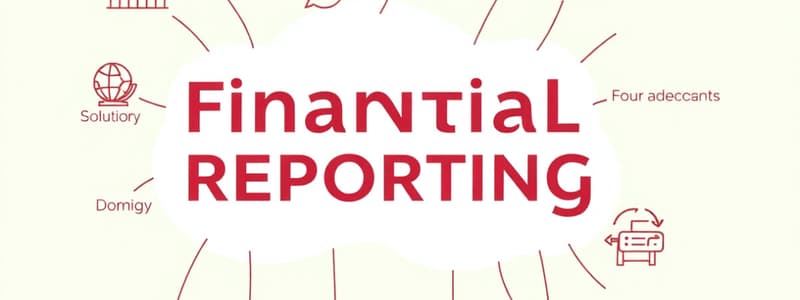Podcast
Questions and Answers
Which of the following is a qualitative characteristic of financial information?
Which of the following is a qualitative characteristic of financial information?
- Materiality (correct)
- Matching Principle
- Non-current assets
- Over-provision for Doubtful Debts
What does the term "liability" refer to in the context of a business?
What does the term "liability" refer to in the context of a business?
- The total amount of money the business has earned
- The amount of money a business owes to external parties (correct)
- The value of the business's assets
- The amount of money a business owes to its employees
What is the principle of matching revenue with expenses?
What is the principle of matching revenue with expenses?
- Matching the amount of revenue earned with the amount of profit generated.
- Ensuring that all expenses are recorded in the same accounting period as the revenue they helped generate. (correct)
- Matching the amount of revenue earned with the amount of liabilities incurred.
- Matching the amount of revenue earned with the amount of assets purchased.
What is the definition of "owner's equity"?
What is the definition of "owner's equity"?
What does the term "prepaid expenses" refer to?
What does the term "prepaid expenses" refer to?
What is the purpose of a provision for doubtful debts?
What is the purpose of a provision for doubtful debts?
Which of the following is an example of an over-provision for doubtful debts?
Which of the following is an example of an over-provision for doubtful debts?
What is the key difference between current assets and non-current assets?
What is the key difference between current assets and non-current assets?
What is the primary purpose of revenue?
What is the primary purpose of revenue?
What does the accounting period concept state?
What does the accounting period concept state?
Which of the following is NOT a limitation of financial reports?
Which of the following is NOT a limitation of financial reports?
What is the purpose of a stocktake?
What is the purpose of a stocktake?
Which of the following is an example of an accrued expense?
Which of the following is an example of an accrued expense?
What is the difference between GST collected and GST credits received?
What is the difference between GST collected and GST credits received?
What is the purpose of the going concern principle?
What is the purpose of the going concern principle?
What is the formula for calculating the current ratio?
What is the formula for calculating the current ratio?
Which of the following is NOT an example of an asset?
Which of the following is NOT an example of an asset?
What is the purpose of a balance day adjustment?
What is the purpose of a balance day adjustment?
What is the difference between a bad debt and a doubtful debt?
What is the difference between a bad debt and a doubtful debt?
What is the purpose of depreciation expense?
What is the purpose of depreciation expense?
Flashcards
Accounting Period Concept
Accounting Period Concept
A financial year from 1 July to 30 June in Australia.
Accrued Expenses
Accrued Expenses
Expenses that have been incurred but not yet paid.
Accrued Revenue
Accrued Revenue
Revenue that has been earned but not yet received.
Assets
Assets
Signup and view all the flashcards
Bad Debts
Bad Debts
Signup and view all the flashcards
Doubtful Debts
Doubtful Debts
Signup and view all the flashcards
Depreciation
Depreciation
Signup and view all the flashcards
GST Credits
GST Credits
Signup and view all the flashcards
Inventory Adjustment
Inventory Adjustment
Signup and view all the flashcards
GST Clearing
GST Clearing
Signup and view all the flashcards
Liability
Liability
Signup and view all the flashcards
Limitations of financial reports
Limitations of financial reports
Signup and view all the flashcards
Matching principle
Matching principle
Signup and view all the flashcards
Materiality
Materiality
Signup and view all the flashcards
Non-current assets
Non-current assets
Signup and view all the flashcards
Owner’s Equity
Owner’s Equity
Signup and view all the flashcards
Provision for Doubtful Debts
Provision for Doubtful Debts
Signup and view all the flashcards
Qualitative characteristics
Qualitative characteristics
Signup and view all the flashcards
Revenue
Revenue
Signup and view all the flashcards
Prepaid expenses
Prepaid expenses
Signup and view all the flashcards
Study Notes
Financial Statement Reporting Glossary
-
Accounting period: A 12-month period, typically from July 1 to June 30 in Australia.
-
Accounting entity concept: Separates the business owner from the business for accounting purposes.
-
Accounting period concept: Divides the business's life into arbitrary time periods for accounting.
-
Accrued expenses: Expenses incurred in a period but not yet paid.
-
Accrued revenue: Revenue earned in a period but not yet received.
-
Assets: Items a business owns or controls.
-
Bad debts: Accounts receivable that cannot pay their debts.
-
Bad debts recovered: When a previously written-off bad debt is paid.
-
Balance Day Adjustments: Entries made at the end of an accounting period to match revenues and expenses accurately to determine profit and to account for previously unrecorded assets/liabilities.
-
Comparative financial statements: Compare current financial statements with previous periods.
-
Current Ratio: The liquidity ratio (current assets/current liabilities), used to assess a company's ability to pay its short-term debts. A current ratio greater than 2:1 is generally considered favourable.
-
Depreciation: The allocation of an asset's cost over its useful life. Used typically for physical assets.
-
Doubtful debts: Estimates of debts expected to be bad from past sales; used because of the matching principle.
-
Expenses: Resource outflows from business operations.
-
Going concern principle: Assumes a business will continue operating indefinitely.
-
Gross profit ratio: Gross profit / net sales x 100; Measures how much gross profit is generated for each dollar of sales.
-
GST credits received: GST paid on expenses and asset acquisition.
-
GST collected: GST collected from sales of inventory, assets, and services, payable to the Australian Tax Office (ATO).
-
GST clearing: A ledger account to calculate GST owed to/by the ATO at the end of the accounting period.
-
Historical cost principle: All assets are initially recorded at the cash price paid at acquisition.
Additional Concepts (Page 2)
-
Inventory adjustment: Ensures inventory count equals accounting records, handling shortages/surpluses.
-
Liabilities: Amounts owed to external parties.
-
Limitations of financial reports: Accounting reports rely on concepts and principles; may have limitations in accuracy and reliability.
-
Matching principle: Matches revenues in one period to expenses incurred in earning those revenues.
-
Materiality: Importance of an item relative to a particular entity; only material costs are included in the cost price of an asset.
-
Monetary principle: All transactions are recorded in a common monetary unit.
-
Net profit ratio: Calculated as net profit / net sales, measures profitability per dollar of sales.
-
Non-current assets: Assets used in business operations longer than one accounting period.
-
Over-provision for doubtful debts: Opening balance of provision for doubtful debts is higher than bad debts during the period.
-
Owner's Equity: The difference between a business's assets and liabilities representing owner investment.
-
Prepaid expenses: Cash payments recorded as assets until their benefit is used.
-
Provision for doubtful debts: Estimates of debts unlikely to be paid in the next period; helps with the matching principle.
-
Qualitative characteristics of financial information: Characteristics like relevance, reliability, comparability, and understandability for financial reports.
-
Quick ratio: Indicates a company's ability to meet immediate debts using quick assets (cash, near cash, receivables) / current liabilities. A ratio > 1:1 is favorable.
-
Revenue: Inflows of resources from business operations.
-
Return on owner's equity: A measure of profitability related to owner investment. =(net profit / avg owner's equity) * 100
-
Return on total assets: Measure of profitability relative to total assets, a measure of how well a company uses its assets to generate profit. =(net profit/ avg total assets)*100
Additional Concepts (Page 3)
-
Statement of Financial Position: Shows a company's assets, liabilities, and owner's equity at a specific time.
-
Statement of Profit or Loss: Summarizes a company's revenues and expenses over a period, resulting in profit or loss.
-
Turnover of accounts receivable Effectiveness of collections, evaluates if accounts receivable are too high. Calculated as (Net Credit Sales) / (Average Accounts Receivable)
-
Turnover of inventory: Measures how quickly inventory is sold, indicating inventory liquidity = (Cost of Goods Sold) / (Average Inventory)
-
Under-provision for doubtful debts: Opening balance of provision for doubtful debts is lower than bad debts written-off during the period.
-
Unearned revenue: Revenue received in advance for future services.
-
Write-off debt: When a debt is marked as no longer collectible.
Studying That Suits You
Use AI to generate personalized quizzes and flashcards to suit your learning preferences.




